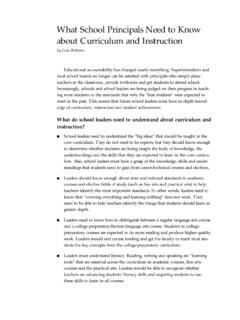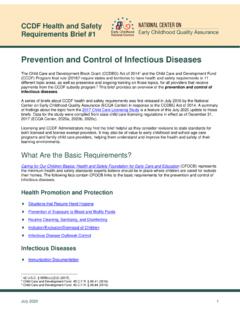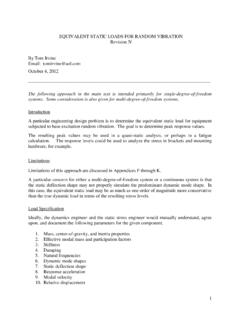Transcription of WORKBOOK A: CREATING A COMMUNICATIONS PLAN
1 WORKBOOK A: CREATING A. COMMUNICATIONS plan . TABLE OF CONTENTS. OVERVIEW OF COMMUNICATIONS 3. Steps Involved in CREATING a COMMUNICATIONS 4. Deciding Whether or Not to Outsource COMMUNICATIONS Planning .. 5. OUTSOURCING COMMUNICATIONS 6. COMMUNICATIONS PLANNING USING INTERNAL RESOURCES:.. 7. 1. Establishing the Goals for Your communication plan .. 7. 2. Defining Key Audiences .. 9. Who Do You Ultimately Want to Influence?.. 9. How Can You Reach Your Target Audiences?.. 11. 3. Identifying Key 12. 4. CREATING A Tactical Outreach 14. Developing Your Media 14. CREATING an Advisory Board .. 15. Media Training for Spokespeople .. 16. Setting Up Editorial Board Meetings .. 16. Hosting Community Forums .. 17. Arranging One-on-one Meetings with Key Influencers .. 17. 5. Developing Materials .. 19. Press Kits .. 19. Press 20. Op-ed 21. Byline 21. Letters to the Editor .. 21. Newsletters .. 22. Public Service Announcements (PSAs) .. 22. B-Rolls (Background Videos).
2 23. 6. specifying a Timeline .. 24. 7. Post-study: Communicating Your Research Results .. 26. Update Your Media Lists .. 26. Brief Your Advisory Board .. 26. Set Up an Editorial Board Meeting .. 27. Host Community Forums .. 27. Arrange One-on-one Meetings with Key Influencers .. 27. Update Your Press 28. Issue A Press Release .. 28. Host a Press Conference .. 28. Publish an Op-ed Article .. 29. Newsletters .. 29. Reissue Your 29. Timeline of Post-Market Study Outreach 30. WORKBOOK A -2- CREATING a COMMUNICATIONS plan OVERVIEW OF COMMUNICATIONS PLANNING. This WORKBOOK presents information about how to develop a COMMUNICATIONS plan for times when your OST Research Task Force needs to inform or educate key audiences or the general public about your work on OST programs. Why do you need a COMMUNICATIONS plan ? A communication plan will help ensure the success of your community's OST. programming planning effort by engaging stakeholders in the process and shaping the way the effort is perceived by everyone invested in or affected by this issue.
3 Your communication plan can help you raise public awareness of your community's OST. needs, challenges, and successes, and obtain needed funding and support. It can also help you to develop or enhance OST programming and increase enrollment. Most organizations that are conducting market research to guide their OST planning will have limited resources, both in terms of the amount of time and money they can spend on the process. Developing a strategic COMMUNICATIONS plan will help you make the most of your resources by establishing priorities and focusing on the most important tasks. Expect to learn a lot in developing your communication plan : you will clarify your objectives and zero in on your target audience. Furthermore, a solid COMMUNICATIONS plan will help ensure that everyone involved in your OST initiative is on the same page when they are communicating about the project with the rest of the world. There are two points at which effective communication is essential: At the beginning of the research process, when important stakeholders are identified and engaged with respect to OST programs.
4 At the end of the research process, when the main tasks are reporting the market research findings and using the results to decide what kinds of OST. programs will be created in your community. The steps involved in developing a COMMUNICATIONS plan are basically the same regardless of what stage of the research process you are in. In this WORKBOOK , we will focus on the first point, the beginning of the research process. At the conclusion of this WORKBOOK , we have included information about considerations for your COMMUNICATIONS plan at the end of your research process. WORKBOOK A -3- CREATING a COMMUNICATIONS plan Steps Involved in CREATING a COMMUNICATIONS plan 1. Establishing the Goals for Your communication plan (What is your ultimate goal? How do your want your OST initiative to be perceived?). 2. Defining Key Audiences (Who do you ultimately want to influence, and how can you reach them?). 3. Identifying Key Messages (What messages are going to resonate most strongly with your key audiences?)
5 4. CREATING a Tactical Outreach plan (How are you going to get your messages to your audiences?). 5. Developing Materials (Descriptions of materials you may want to develop to convey your messages to your audiences.). 6. specifying A Timeline (We present a recommended timeline to follow, coordinating your research and your communication plan .). 7. Post-study: Communicating Your Research Results (Considerations for communicating with your audience after your research has been completed.). WORKBOOK A -4- CREATING a COMMUNICATIONS plan Deciding Whether or Not to Outsource COMMUNICATIONS Planning In determining whether or not to outsource all or part of your COMMUNICATIONS planning, it is important to consider your available resources. You may also decide to enlist the help of a consultant to help at the beginning or with certain aspects of marketing and COMMUNICATIONS . When to outsource COMMUNICATIONS planning: Consider hiring a marketing, advertising, or COMMUNICATIONS firm if: (1) you are concerned about presenting your ideas in the most positive light possible, or are uncertain about which means of communication will best serve your needs for your OST initiative; (2) if local media are unresponsive to your requests for coverage ( , won't run public service announcements, refuse to send reporters, etc.)
6 ; or (3) if key influencers in the market are opposed to OST. programs for some reason and begin using local media (newspapers, radio, or television) to air their opposition. When to conduct COMMUNICATIONS planning using internal resources: Consider conducting your COMMUNICATIONS plan using internal resources if the members of your OST Research Task Force have sufficient knowledge, skills and understanding of marketing. In the next sections, we will present more detailed information regarding outsourcing your COMMUNICATIONS plan and conducting COMMUNICATIONS plans using internal resources. For communities conducting COMMUNICATIONS plans using internal resources, we will present information about each step in the process. WORKBOOK A -5- CREATING a COMMUNICATIONS plan OUTSOURCING COMMUNICATIONS PLANNING: A Guide to Hiring Vendors Marketing and COMMUNICATIONS agency Advertising agency Who to hire: Independent freelance consultant Public affairs organization Has demonstrated skills and expertise in social marketing Experience working on community initiatives What to look for: Experience working with diverse groups that include non- profit and government organizations as well as businesses Talk to local nonprofit organizations and ask for a recommendation Local chamber of commerce or similar organizations Where to find vendors: Local industry organizations such as an advertising club or the Public Relations Society of America Speak with professors at a local college and ask for their recommendations Discuss your objectives with you in detail Review market research information you have collected What they will do.
7 Create a COMMUNICATIONS plan designed to meet your objectives Produce necessary TV, radio, print, and/or web strategies Provide vendor with a clear understanding of your objectives Provide vendor with market research data your organization What you will do: has generated or obtained through other sources Be available for necessary public statements, interviews, debates Fees vary widely depending on the scope of services and size of agency Expect to pay $1,500 to $10,000 for specific tasks, such as What you should preparing press releases, developing a video, etc. expect to pay: Expect to pay $1,500 to $5,000 per month for a consultant who will work with you throughout the planning process and will create and execute a comprehensive COMMUNICATIONS plan for OST programs in your community WORKBOOK A -6- CREATING a COMMUNICATIONS plan COMMUNICATIONS PLANNING. USING INTERNAL RESOURCES: 1. Establishing the Goals for Your communication plan The five steps involved in CREATING a COMMUNICATIONS plan are: (1) establishing goals; (2) defining key audiences; (3) identifying key messages; (4) CREATING a tactical outreach plan ; and (5) specifying a timeline for moving forward.
8 We will discuss each of these steps in turn. The first step to producing a successful COMMUNICATIONS plan is to establish a set of clear and measurable goals. These goals highlight the desired outcome of promoting the OST research initiative and are not the same as the defined expectations for the program itself. When you begin your OST research planning process, the objective of the COMMUNICATIONS plan is to engage important stakeholders' participation in the design and execution of a market research study. As you complete the planning process, the objective of the COMMUNICATIONS plan shifts toward informing stakeholders of the results of the market research and setting the stage for broad community support for the OST. programs you have come up with in response to the market research. guidelines for CREATING the goals for your COMMUNICATIONS plan Your COMMUNICATIONS goals should be realistic and action-oriented. Goals should be specific and measurable.
9 Keep to a minimal number of goals ( , one to three). You cannot achieve everything with one initiative. Know your audience ( , parents, stakeholders, media). Who will be receiving the messages you will be communicating? We will present more details about this step in the next section. For example, the goal for your initial COMMUNICATIONS plan could be, Educate 90% of the stakeholders we've identified in our community about the OST planning process and OST programs we are considering. Another goal might be to convert 70%. of the stakeholders you have educated through various media into public advocates of the survey or whatever other market research process you engage in or simply to generate public support for the market research, ultimately leading to increased participation in the creation of OST programs.. WORKBOOK A -7- CREATING a COMMUNICATIONS plan POINTER. When establishing your goals, be clear, direct, straightforward, and oriented toward solutions.
10 Coming Up With Goals: A Checklist ; Solution-oriented goals (goals that can actually be achieved) are specific and focused rather than broad. ; Are your goals clear and pragmatic rather than vague and overwhelming? ; Can the goals be linked to indicators or measures so you know if you've succeeded? ; Remember that your COMMUNICATIONS plan resources include MONEY and TIME. Have you picked goals that can be met within your resource constraints? ; No COMMUNICATIONS plan changes everything. Have you chosen two or three goals that make the most sense given our mission? ; If your group spends more than an evening or two arguing about a goal, go back to your mission and choose an alternative. How long have you spent deciding on this goal? Source: Market Street Research, Inc., Trainer Information and Worksheets for School-Linked Services, Massachusetts Department of Education, Boston, Massachusetts, for training workshops held 1997 to 2001. WORKBOOK A -8- CREATING a COMMUNICATIONS plan 2.













